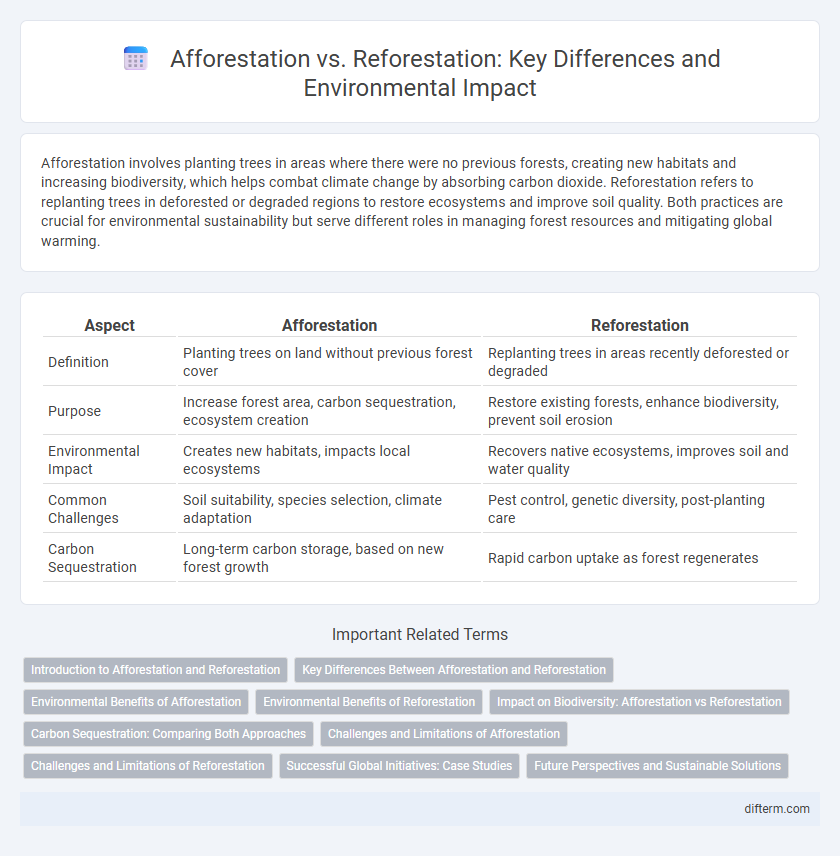Afforestation involves planting trees in areas where there were no previous forests, creating new habitats and increasing biodiversity, which helps combat climate change by absorbing carbon dioxide. Reforestation refers to replanting trees in deforested or degraded regions to restore ecosystems and improve soil quality. Both practices are crucial for environmental sustainability but serve different roles in managing forest resources and mitigating global warming.
Table of Comparison
| Aspect | Afforestation | Reforestation |
|---|---|---|
| Definition | Planting trees on land without previous forest cover | Replanting trees in areas recently deforested or degraded |
| Purpose | Increase forest area, carbon sequestration, ecosystem creation | Restore existing forests, enhance biodiversity, prevent soil erosion |
| Environmental Impact | Creates new habitats, impacts local ecosystems | Recovers native ecosystems, improves soil and water quality |
| Common Challenges | Soil suitability, species selection, climate adaptation | Pest control, genetic diversity, post-planting care |
| Carbon Sequestration | Long-term carbon storage, based on new forest growth | Rapid carbon uptake as forest regenerates |
Introduction to Afforestation and Reforestation
Afforestation involves planting trees in areas that have never been forested, contributing to carbon sequestration and biodiversity enhancement. Reforestation refers to restoring forest cover in regions where trees have been removed or destroyed, aiding ecosystem recovery and soil stabilization. Both practices are vital for combating climate change and maintaining ecological balance.
Key Differences Between Afforestation and Reforestation
Afforestation involves planting trees in areas that have never been forested to create new forests, whereas reforestation refers to replanting trees in regions where forests were previously cut down or destroyed. Afforestation contributes to carbon sequestration by expanding forest cover on barren land, while reforestation primarily aims to restore ecosystems and biodiversity in deforested areas. Key differences include the land type--non-forested for afforestation and deforested for reforestation--and the goals related to environmental restoration and climate mitigation.
Environmental Benefits of Afforestation
Afforestation significantly enhances biodiversity by creating new habitats for wildlife and restoring ecosystem balance. It contributes to carbon sequestration, reducing atmospheric CO2 levels and mitigating climate change effects. Moreover, afforestation improves soil quality, prevents erosion, and supports water cycle regulation, promoting overall environmental sustainability.
Environmental Benefits of Reforestation
Reforestation enhances biodiversity by restoring native habitats and supporting wildlife populations, which helps maintain ecosystem balance. It plays a critical role in carbon sequestration, reducing greenhouse gases and mitigating climate change effects. Reforested areas also improve soil quality, prevent erosion, and regulate water cycles, contributing to overall environmental health.
Impact on Biodiversity: Afforestation vs Reforestation
Afforestation introduces new forested areas on previously non-forested land, potentially altering existing ecosystems and sometimes reducing local biodiversity by replacing native habitats. Reforestation restores forests on previously deforested land, supporting the recovery of native species and enhancing biodiversity through habitat restoration. Both processes impact biodiversity differently, with reforestation generally promoting greater ecological balance and native species resurgence compared to afforestation.
Carbon Sequestration: Comparing Both Approaches
Afforestation involves planting trees in areas without previous forest cover, creating new carbon sinks that absorb atmospheric CO2 over long periods, whereas reforestation restores deforested or degraded forests, rapidly enhancing existing ecosystems' carbon storage capacity. Studies indicate afforestation can sequester up to 200 tons of CO2 per hectare over several decades, while reforestation often achieves quicker carbon uptake due to established soil and root systems. Both approaches significantly contribute to climate change mitigation by increasing biomass carbon stocks and improving soil carbon sequestration, but their effectiveness depends on site conditions and forest management practices.
Challenges and Limitations of Afforestation
Afforestation faces significant challenges including soil degradation and unsuitable land conditions, which hinder tree growth and long-term ecosystem stability. Limited biodiversity in afforested areas often fails to replicate natural forest ecosystems, reducing habitat quality for native species. Water resource depletion and high maintenance costs further constrain the scalability and sustainability of afforestation projects.
Challenges and Limitations of Reforestation
Reforestation efforts often face challenges such as soil degradation, limited biodiversity restoration, and the risk of monoculture plantations reducing ecosystem resilience. Inadequate funding and long-term maintenance difficulties further limit the success of reforestation projects. Additionally, climate change exacerbates these issues by altering growth conditions and increasing vulnerability to pests and diseases.
Successful Global Initiatives: Case Studies
Afforestation projects such as China's Green Great Wall have effectively combated desertification, while reforestation efforts like Brazil's Amazon restoration program have significantly enhanced biodiversity and carbon sequestration. In Kenya, the Green Belt Movement empowers communities to plant millions of trees, demonstrating the socio-environmental impact of reforestation. These successful global initiatives highlight the critical role of large-scale tree planting in mitigating climate change and restoring ecosystems.
Future Perspectives and Sustainable Solutions
Afforestation initiatives, by creating new forests on previously non-forested lands, offer a proactive approach to carbon sequestration and biodiversity enhancement, addressing climate change with innovative land management. Reforestation efforts restore degraded forest ecosystems, improving soil health and water cycles, which are critical for long-term environmental resilience. Combining afforestation and reforestation with community-led sustainable practices and advanced monitoring technologies ensures scalable and adaptive solutions for future global sustainability challenges.
afforestation vs reforestation Infographic

 difterm.com
difterm.com